Tracking Biosecurity Through the Diversity and Network Structure of International Trade
Abstract
1. Introduction
- (i)
- Does the network structure and diversity of import pathways vary over time?
- (ii)
- Do import interceptions vary over time?
- (iii)
- Are there associations between (i) and (ii)?
- (iv)
- Can machine learning tools be used to predict interception levels?
2. Materials and Methods
2.1. Imports Data
2.2. Interceptions Data
2.3. R Packages
2.4. Network Topology
2.4.1. Alatalo Interaction Evenness
2.4.2. Linkage Density
2.4.3. Interaction Strength Asymmetry
2.4.4. Nestedness
2.5. Diversity
2.5.1. Inverse Simpson Index of Diversity (‘1—D’)
2.5.2. Fisher’s Alpha Parameter (α)
2.6. Machine Learning Models
2.6.1. Dataset and Preprocessing
2.6.2. Data Splitting and Modelling
2.6.3. Evaluation Metrics
3. Results
3.1. Import Pathways
3.2. Interception Patterns
3.3. Network Structure, Diversity Indices and Transport Mode
3.4. Relationships Between Import Network, Diversity and Interceptions
3.5. Machine Learning
4. Discussion
4.1. Import Pathways
4.2. Interception Patterns
4.3. Network Structure
4.4. Diversity Indices
4.5. Associations
4.6. Machine Learning
4.7. Applications
4.8. Limitations
5. Conclusions and Further Directions
- (i)
- For the three-year period studied, the network structure and diversity of import pathways demonstrated variation across time, with consistent peaks and troughs for several measures.
- (ii)
- The number of interceptions, and number of intercepted taxa, also varied over this period.
- (iii)
- Network Linkage density and Inverse Simpson Diversity of imports correlated to number of intercepted taxa. No bivariate correlation was found to number of interceptions.
- (iv)
- The machine learning frameworks of Random Forest and XGBoost showed the potential to predict number of interceptions, and number of intercepted taxa, within a useful range.
Supplementary Materials
Author Contributions
Funding
Institutional Review Board Statement
Data Availability Statement
Acknowledgments
Conflicts of Interest
References
- Hulme, P.E. Trade, transport and trouble: Managing invasive species pathways in an era of globalization. J. Appl. Ecol. 2009, 46, 10–18. [Google Scholar] [CrossRef]
- Seebens, H.; Essl, F.; Dawson, W.; Fuentes, N.; Moser, D.; Pergl, J.; Pyšek, P.; van Kleunen, M.; Weber, E.; Winter, M.; et al. Global trade will accelerate plant invasions in emerging economies under climate change. Glob. Chang. Biol. 2015, 21, 4128–4140. [Google Scholar] [CrossRef] [PubMed]
- Turner, R.M.; Brockerhoff, E.G.; Bertelsmeier, C.; Blake, R.E.; Caton, B.; James, A.; MacLeod, A.; Nahrung, H.F.; Pawson, S.M.; Plank, M.J.; et al. Worldwide border interceptions provide a window into human-mediated global insect movement. Ecol. Appl. 2021, 31, e02412. [Google Scholar] [CrossRef]
- Eschen, R.; Britton, K.; Brockerhoff, E.G.; Burgess, T.I.; Dalley, V.; Epanchin-Niell, R.S.; Gupta, K.; Hardy, G.E.S.J.; Huang, Y.; Kenis, M.; et al. International variation in phytosanitary legislation and regulations governing importation of plants for planting. Environ. Sci. Policy 2015, 51, 228–237. [Google Scholar] [CrossRef]
- Allen, E.; Noseworthy, M.; Ormsby, M. Phytosanitary measures to reduce the movement of forest pests with the international trade of wood products. Biol. Invasions 2017, 19, 3365–3376. [Google Scholar] [CrossRef]
- Epanchin-Niell, R.S.; McAusland, C.; Liebhold, A.M.; Mwebaze, P.; Springborn, M.R. Biological invasions and international trade: Managing a moving target. Rev. Environ. Econ. Policy 2021, 15, 180–190. [Google Scholar] [CrossRef]
- GovUK The Border Target Operating Model: August 2023. Available online: https://www.gov.uk/government/publications/the-border-target-operating-model-august-2023/the-border-target-operating-model-august-2023 (accessed on 1 December 2024).
- Defra. Plant Health—International Trade and Controlled Consignments, 2017–2021—Experimental Statistics Publication. Available online: https://www.gov.uk/government/statistics/plant-health-international-trade-and-controlled-consignments-2017-2021-experimental-statistics-publication (accessed on 1 December 2024).
- GovUK Plant Biosecurity Strategy for Great Britain (2023 to 2028). Available online: https://www.gov.uk/government/publications/plant-biosecurity-strategy-for-great-britain-2023-to-2028 (accessed on 1 December 2024).
- Buddenhagen, C.E.; Rubenstein, J.M.; Hampton, J.G.; Rolston, M.P. The phytosanitary risks posed by seeds for sowing trade networks. PLoS ONE 2021, 16, e0259912. [Google Scholar] [CrossRef]
- Colunga-Garcia, M.; Haack, R.A.; Magarey, R.D.; Borchert, D.M. Understanding trade pathways to target biosecurity surveillance. NeoBiota 2013, 18, 103–118. [Google Scholar] [CrossRef]
- Marshall, M. Implementing Biosecurity in Live Plant Trade Networks. Ph.D. Thesis, Lincoln University, Lincoln, New Zealand, 2022. Available online: https://researcharchive.lincoln.ac.nz/server/api/core/bitstreams/22c46551-024e-41c3-873a-774a40db805a/content (accessed on 1 December 2024).
- Hinsley, A.; Hughes, A.C.; van Valkenburg, J.; Stark, T.; van Delft, J.; Sutherland, W.; Petrovan, S.O. Understanding the environmental and social risks from the international trade in ornamental plants. BioScience 2025, 124. [Google Scholar] [CrossRef]
- Chen, J. Ornamental plant research inaugural editorial. Ornam. Plant Res. 2021, 1, 1–2. [Google Scholar] [CrossRef]
- Smith, R.M.; Baker, R.H.A.; Malumphy, C.P.; Hockland, S.; Hammon, R.P.; Ostojá-Starzewski, J.C.; Collins, D.W. Recent non-native invertebrate plant pest establishments in Great Britain: Origins, pathways, and trends. Agric. For. Entomol. 2007, 9, 307–326. [Google Scholar] [CrossRef]
- Brasier, C.M. The biosecurity threat to the UK and global environment from international trade in plants. Plant Pathol. 2008, 57, 792–808. [Google Scholar] [CrossRef]
- Straw, N.; Fielding, N.J.; Tilbury, C.A.; Williams, C.D.; Cull, T. History and development of an isolated outbreak of Asian longhorn beetle Anoplophora glabripennis (Coleoptera: Cerambycidae) in southern England. Agric For Entomol. 2016, 18, 280–293. [Google Scholar] [CrossRef]
- Eyre, D.; Barbrook, J. The eradication of Asian longhorned beetle at Paddock Wood, UK. CABI Agric. Biosci. 2021, 2, 12. [Google Scholar] [CrossRef]
- Renault, D.; Angulo, E.; Cuthbert, R.N.; Haubrock, P.J.; Capinha, C.; Bang, A.; Kramer, A.M.; Courchamp, F. The magnitude, diversity, and distribution of the economic costs of invasive terrestrial invertebrates worldwide. Sci. Total Environ. 2022, 835, 155391. [Google Scholar] [CrossRef]
- Haubrock, P.J.; Turbelin, A.J.; Cuthbert, R.N.; Novoa, A.; Taylor, N.G.; Angulo, E.; Ballesteros-Mejia, L.; Bodey, T.W.; Capinha, C.; Diagne, C.; et al. Economic costs of invasive alien species across Europe. In Zenni, R.D., McDermott, S., García-Berthou, E., Essl, F., Eds.: The economic costs of biological invasions around the world. NeoBiota 2021, 67, 153–190. [Google Scholar] [CrossRef]
- Turner, R.M.; Liebhold, A.M.; Nahrung, H.F.; Caton, B.; Seebens, H.; Yamanaka, T.; Liebhold, A.M. The known unknowns in international border interceptions of non-native insects. Biol. Invasions 2025, 27, 50. [Google Scholar] [CrossRef]
- Brockerhoff, E.G.; Kimberley, M.; Liebhold, A.M.; Haack, R.A.; Cavey, J.F. Predicting how altering propagule pressure changes establishment rates of biological invaders across species pools. J. Ecol. 2014, 95, 594–601. [Google Scholar] [CrossRef]
- McCullough, D.G.; Work, T.T.; Cavey, J.F.; Liebhold, A.M.; Marshall, D. Interceptions of Nonindigenous Plant Pests at US Ports of Entry and Border Crossings Over a 17-year Period. Biol. Invasions 2006, 8, 611–630. [Google Scholar] [CrossRef]
- Saracco, F.; Di Clemente, R.; Gabrielli, A.; Squartini, T. Detecting early signs of the 2007–2008 crisis in the world trade. Sci. Rep. 2016, 6, 30286. [Google Scholar] [CrossRef]
- Braun, E.; Sebestyén, T.; Kiss, T. The strength of domestic production networks: An economic application of the Finn cycling index. Appl. Netw. Sci. 2021, 6, 69. [Google Scholar] [CrossRef] [PubMed]
- Moslonka-Lefebvre, M.; Finley, A.; Dorigatti, I.; Dehnen-Schmutz, K.; Harwood, T.; Jeger, M.J.; Xu, X.; Holdenrieder, O.; Pautasso, M. Networks in plant epidemiology: From genes to landscapes, countries, and continents. Phytopathology 2011, 101, 392–403. [Google Scholar] [CrossRef] [PubMed]
- HM Revenue & Customs. Bulk Import Datasets Published Under the Open Government Licence. Available online: https://www.uktradeinfo.com/trade-data/latest-bulk-datasets/bulk-datasets-archive/#imports-(bds-imp-yymm) (accessed on 1 December 2024).
- Phytosanitary Conditions Regulation (EU 2019/2072). Available online: https://www.legislation.gov.uk/uksi/2023/1131/made (accessed on 24 December 2024).
- UK Plant Health Information Portal. Available online: https://planthealthportal.defra.gov.uk/trade/imports/alert-list/ (accessed on 1 December 2024).
- Oksanen, J.; Blanchet, F.G.; Kindt, R.; Legendre, P.; Minchin, P.R.; O’Hara, R.B.; Simpson, G.L.; Solymos, P.; Henry, M.; Stevens, H.; et al. R Package, version 2.4-3; Vegan: Community Ecology Package; R Foundation for Statistical Computing: Vienna, Austria, 2017. Available online: https://CRAN.R-project.org/package=vegan (accessed on 1 December 2024).
- Dormann, C.F.; Gruber, B.; Fruend, J. Introducing the bipartite package: Analysing ecological networks. R News 2008, 8, 8–11. [Google Scholar]
- Wickham, H. ggplot2: Elegant Graphics for Data Analysis; Springer: New York, NY, USA, 2016. [Google Scholar]
- Liaw, A.; Wiener, M. Classification and regression by randomForest. R News 2002, 2, 18–22. [Google Scholar]
- Chen, T.; He, T.; Benesty, M.; Khotilovich, V.; Tang, Y.; Cho, H.; Chen, K.; Mitchell, R.; Cano, I.; Zhou, T.; et al. R Package, version 1.7.8.1; xgboost: Extreme Gradient Boosting; R Foundation for Statistical Computing: Vienna, Austria, 2024. Available online: https://CRAN.R-project.org/package=xgboost (accessed on 1 December 2024).
- Greenwell, B.M.; Boehmke, B.C. Variable importance plots—An introduction to the vip package. R J. 2020, 12, 343–366. [Google Scholar] [CrossRef]
- R Core Team. R: A Language and Environment for Statistical Computing; R Foundation for Statistical Computing: Vienna, Austria, 2022; Available online: https://www.R-project.org/ (accessed on 1 December 2024).
- Patefield, W.M. Algorithm AS 159: An efficient method of generating r x c tables with given row and column totals. Appl. Stat. 1981, 30, 91–97. [Google Scholar] [CrossRef]
- Hill, M.O. Diversity and evenness: A unifying notation and its consequences. Ecology 1973, 54, 427–432. [Google Scholar] [CrossRef]
- Alatalo, R.V. Problems in the measurement of evenness in ecology. Oikos 1981, 37, 199–204. [Google Scholar] [CrossRef]
- Bersier, L.F.; Banašek-Richter, C.; Cattin, M.F. Quantitative descriptors of food-web matrices. Ecology 2002, 83, 2394–2407. [Google Scholar] [CrossRef]
- Heleno, R.; Devoto, M.; Pocock, M. Connectance of species interaction networks and conservation value: Is it any good to be well connected? Ecol. Indic. 2012, 14, 7–10. [Google Scholar] [CrossRef]
- Blüthgen, N.; Menzel, F.; Blüthgen, N. Measuring specialization in species interaction networks. BMC Ecol. 2006, 6, 9. [Google Scholar] [CrossRef] [PubMed][Green Version]
- Rodríguez-Gironés, M.A.; Santamaría, L. A new algorithm to calculate the nestedness temperature of presence–absence matrices. J. Biogeogr. 2006, 33, 924–935. [Google Scholar] [CrossRef]
- Burgos, E.; Ceva, H.; Perazzo, R.P.J.; Devoto, M.; Medan, D.; Zimmermann, M.; Delbue, A.M. Why nestedness in mutualistic networks? J. Theor. Biol. 2007, 249, 307–313. [Google Scholar] [CrossRef]
- Sajedianfard, N.; Hadian, E.; Samadi, A.H.; Shabani, Z.D.; Sarkar, S.; Robinson, P.A. Quantitative analysis of trade networks: Data and robustness. Appl. Netw. Sci. 2021, 6, 46. [Google Scholar] [CrossRef]
- Simpson, E.H. Measurement of diversity. Nature 1949, 163, 688. [Google Scholar] [CrossRef]
- Fisher, R.A.; Corbet, A.S.; Williams, C.B. The relation between the number of species and the number of individuals in a random sample of an animal population. J. Anim. Ecol. 1943, 12, 42–58. [Google Scholar] [CrossRef]
- Breiman, L. Random forests. Mach. Learn. 2001, 45, 5–32. [Google Scholar] [CrossRef]
- Chen, T.; Guestrin, C. XGBoost: A Scalable Tree Boosting System. 2016. Available online: https://arxiv.org/abs/1603.02754 (accessed on 1 December 2024).
- Eschen, R.; Grégoire, J.C.; Hengeveld, G.M.; de Hoop, M.B.; Rigaux, L.; Potting, R.P.J. Trade patterns of the tree nursery industry in Europe and changes following findings of citrus longhorn beetle, Anoplophora chinensis Forster. NeoBiota 2015, 26, 1–20. [Google Scholar] [CrossRef]
- Lichtenberg, E.; Olson, L.J. The fruit and vegetable import pathway for potential invasive pest arrivals. PLoS ONE 2018, 13, e0192280. [Google Scholar] [CrossRef]
- Vilà, M.; Dunn, A.M.; Essl, F.; Gómez-Díaz, E.; Hulme, P.E.; Jeschke, J.M.; Nuñez, M.A.; Ostfeld, R.S.; Pauchard, A.; Ricciardi, A.; et al. Viewing emerging human infectious epidemics through the lens of invasion biology. BioScience 2021, 71, 722–740. [Google Scholar] [CrossRef]
- Junqueira, A.H.; Peetz, M. Brazilian consumption of flowers and ornamental plants: Habits, practices and contemporary trends. Ornam. Hortic. 2017, 23, 178–184. [Google Scholar] [CrossRef]
- Hayes, K.R.; Barry, S.C. Are there any consistent predictors of invasion success? Biol. Invasions 2008, 10, 483–506. [Google Scholar] [CrossRef]
- Duncan, R.P.; Blackburn, T.M.; Rossinelli, S.; Bacher, S. Quantifying invasion risk: The relationship between establishment probability and founding population size. Methods Ecol. Evol. 2014, 5, 1255–1263. [Google Scholar] [CrossRef]
- Saccaggi, D.L.; Wilson, J.R.U.; Robinson, A.P.; Terblanche, J.S. Arthropods on imported plant products: Volumes predict general trends while contextual details enhance predictive power. Ecol. Appl. 2022, 32, e2554. [Google Scholar] [CrossRef]
- Plant Atlas 2020. 2020. Available online: https://plantatlas2020.org/index.php/ (accessed on 10 January 2024).
- Hellegers, P. Food security vulnerability due to trade dependencies on Russia and Ukraine. Food Sec. 2022, 14, 1503–1510. [Google Scholar] [CrossRef]
- Banks, N.C.; Paini, D.R.; Bayliss, K.L.; Hodda, M. The role of global trade and transport network topology in the human-mediated dispersal of alien species. Ecol. Lett. 2015, 18, 188–199. [Google Scholar] [CrossRef]
- Dormann, C.F.; Fründ, J.; Blüthgen, N.; Gruber, B. Indices, graphs and null models: Analysing bipartite ecological networks. Open Ecol. J. 2009, 2, 7–24. [Google Scholar] [CrossRef]
- Beck, J.; Schwanghart, W. Comparing measures of species diversity from incomplete inventories: An update. Methods Ecol. Evol. 2010, 1, 38–44. [Google Scholar] [CrossRef]
- Booth, B.D.; Murphy, S.D.; Swanton, C.J. Weed Ecology in Natural and Agricultural Systems; CABI Publishing: Wallingford, CT, USA, 2003. [Google Scholar]
- Hicks, D. Quantitative Methods for the Monitoring and Evaluation of Vegetation Survey Data. In Vegetation Dynamics—Ecosystem Management, Conservation, and Protection; IntechOpen: London, UK, 2024. [Google Scholar] [CrossRef]
- Clarke, L.J.; Shaw, J.D.; Suter, L.; Atalah, J.; Bergstrom, D.M.; Biersma, E.; Convey, P.; Greve, M.; Holland, O.; Houghton, M.J.; et al. An expert-driven framework for applying eDNA tools to improve biosecurity in the Antarctic. Manag. Biol. Invasions 2023, 14, 379–402. [Google Scholar] [CrossRef]
- Abeynayake, S.W.; Fiorito, S.; Dinsdale, A.; Whattam, M.; Crowe, B.; Sparks, K.; Campbell, P.R.; Gambley, C. A rapid and cost-effective identification of invertebrate pests at the borders using MinION sequencing of DNA barcodes. Genes 2021, 12, 1138. [Google Scholar] [CrossRef]
- Madden, M.J.L.; Young, R.G.; Brown, J.W.; Miller, S.E.; Frewin, A.J.; Hanner, R.H. Using DNA barcoding to improve invasive pest identification at U.S. ports-of-entry. PLoS ONE 2019, 14, e0222291. [Google Scholar] [CrossRef] [PubMed]
- Kenis, M.; Rabitsch, W.; Auger-Rozenberg, M.; Roques, A. How can alien species inventories and interception data help us prevent insect invasions? Bull. Entomol. Res. 2007, 97, 489–502. [Google Scholar] [CrossRef] [PubMed]

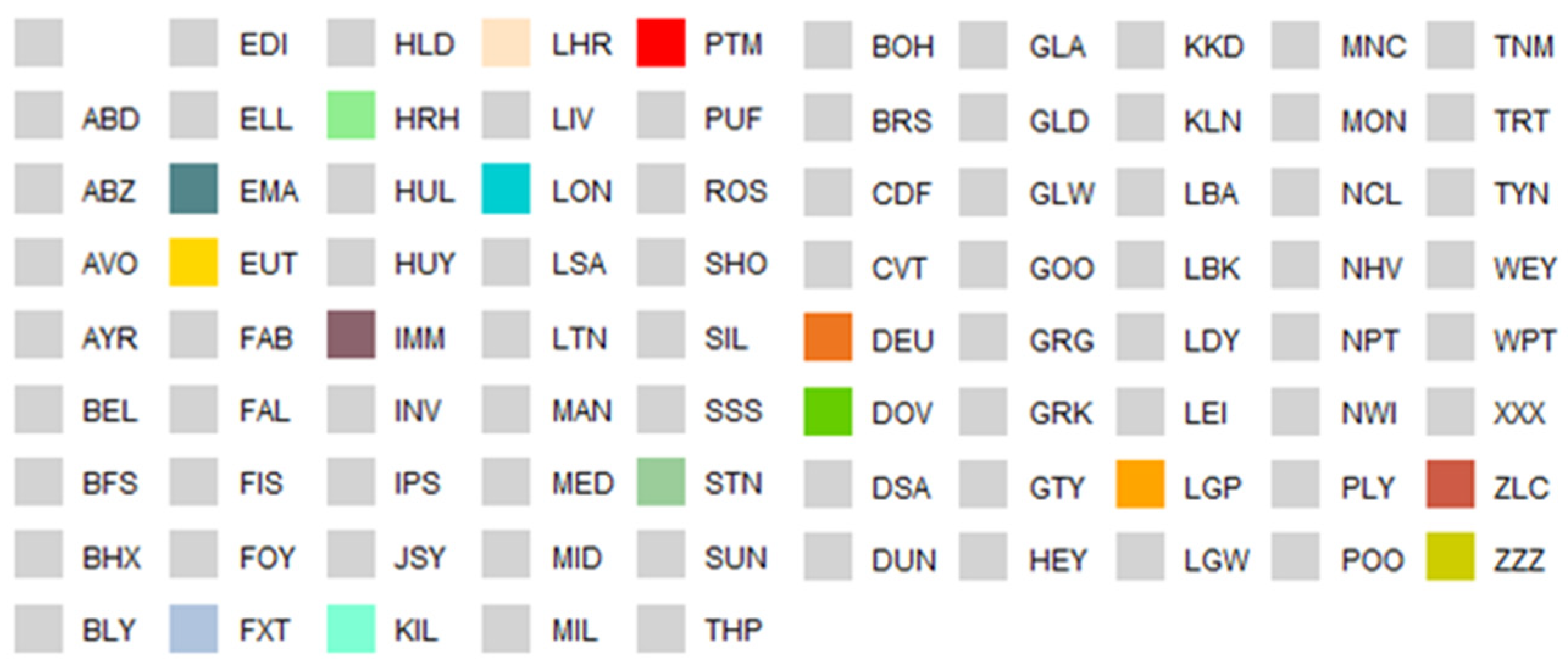
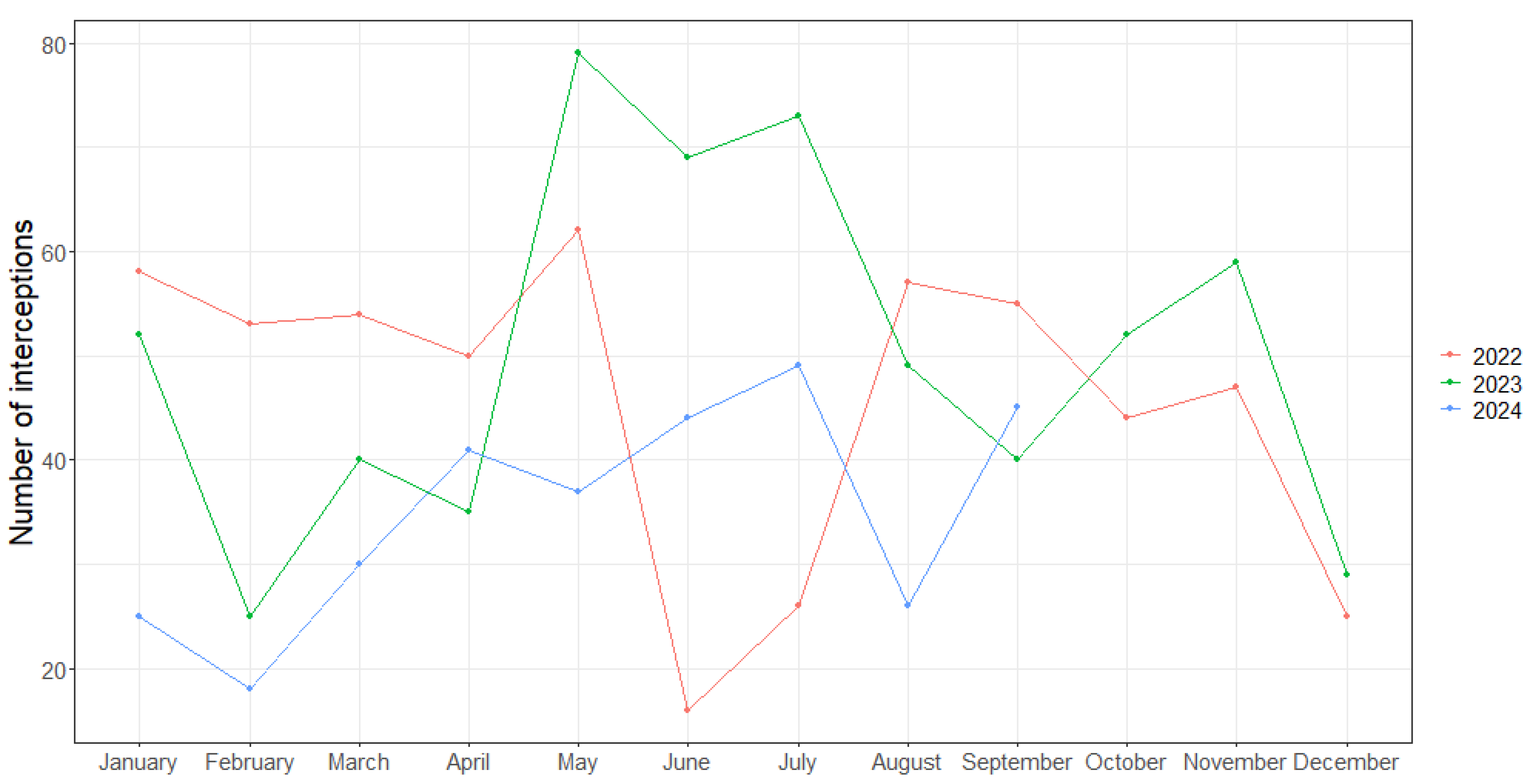
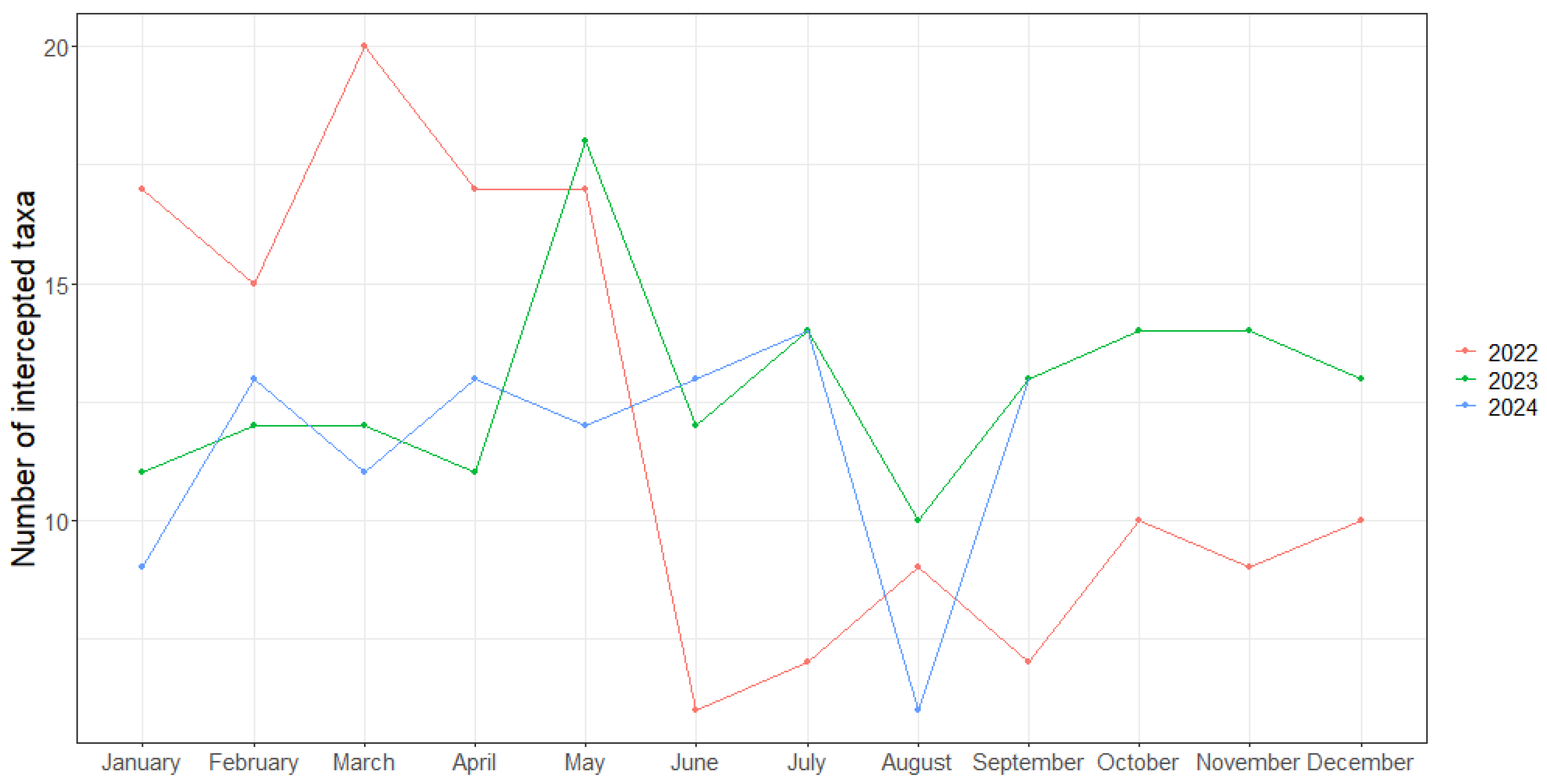
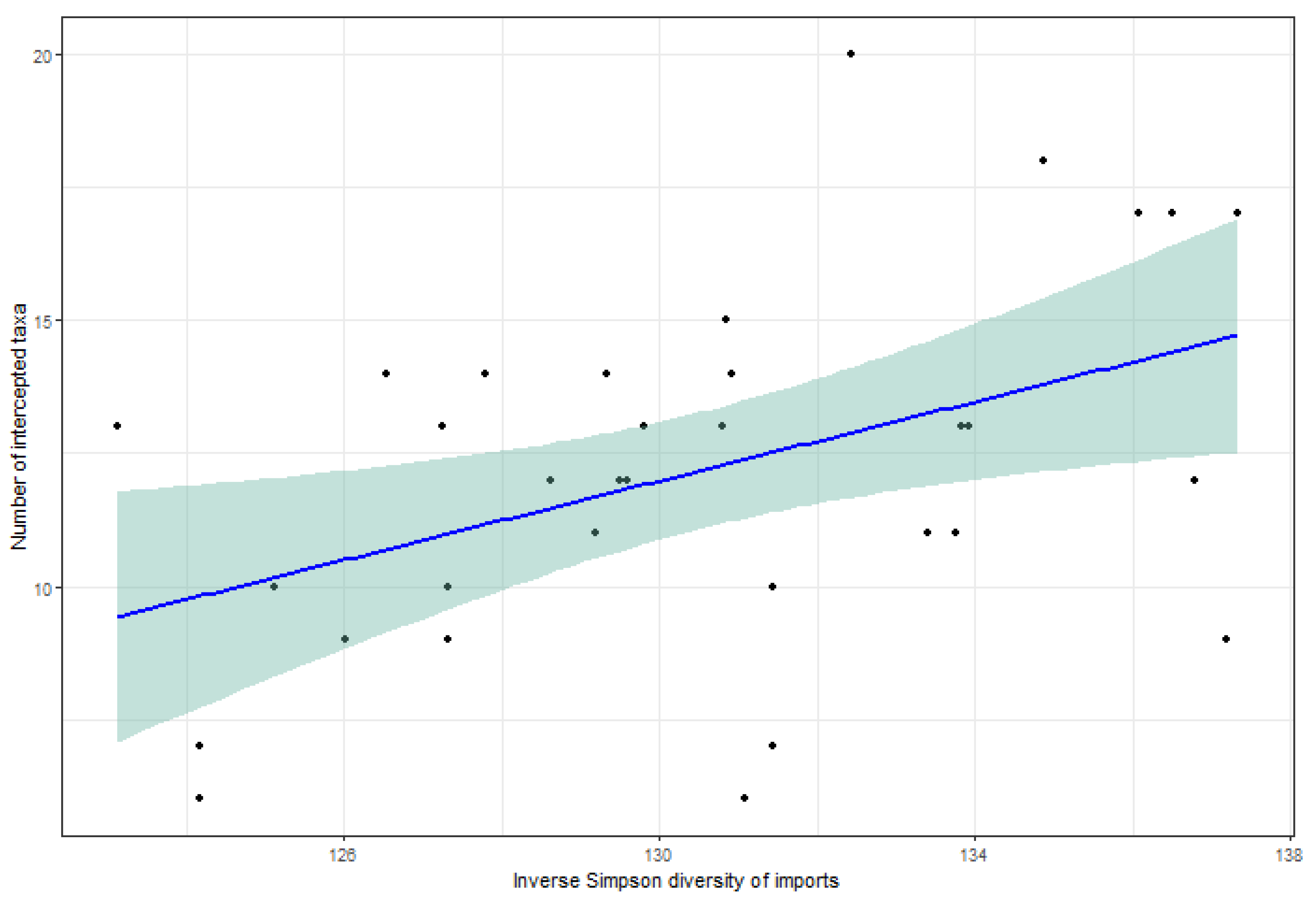
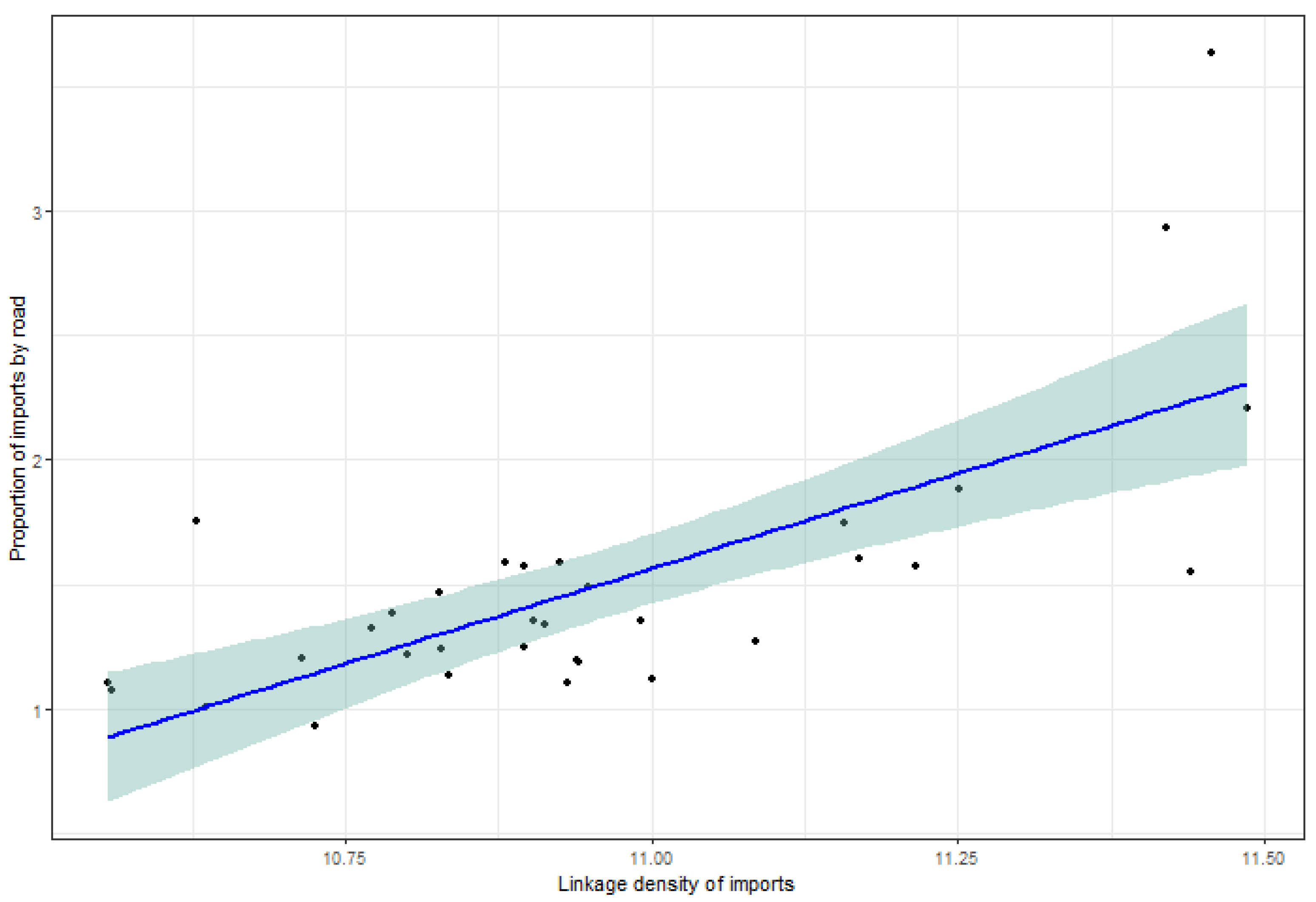
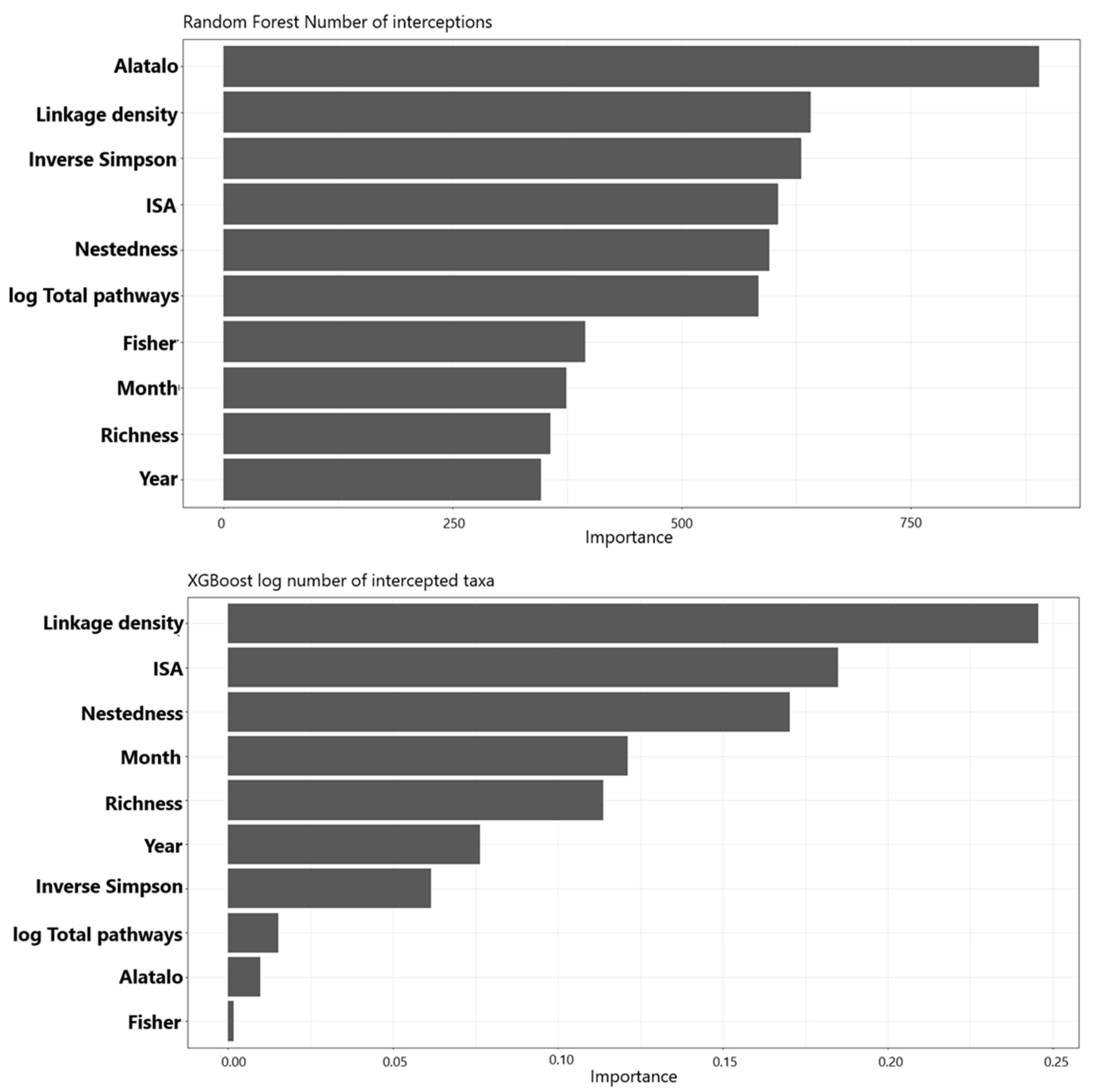
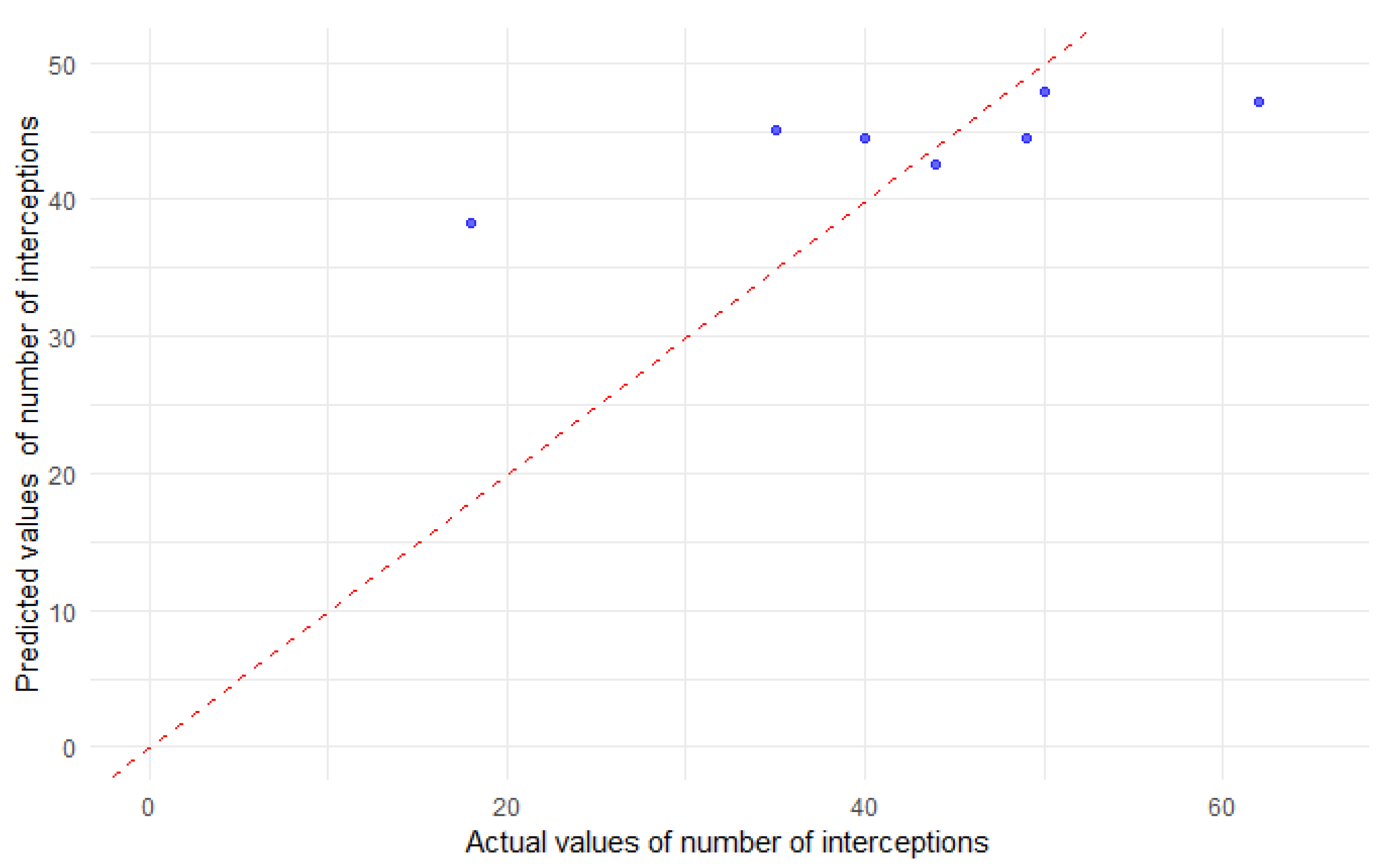
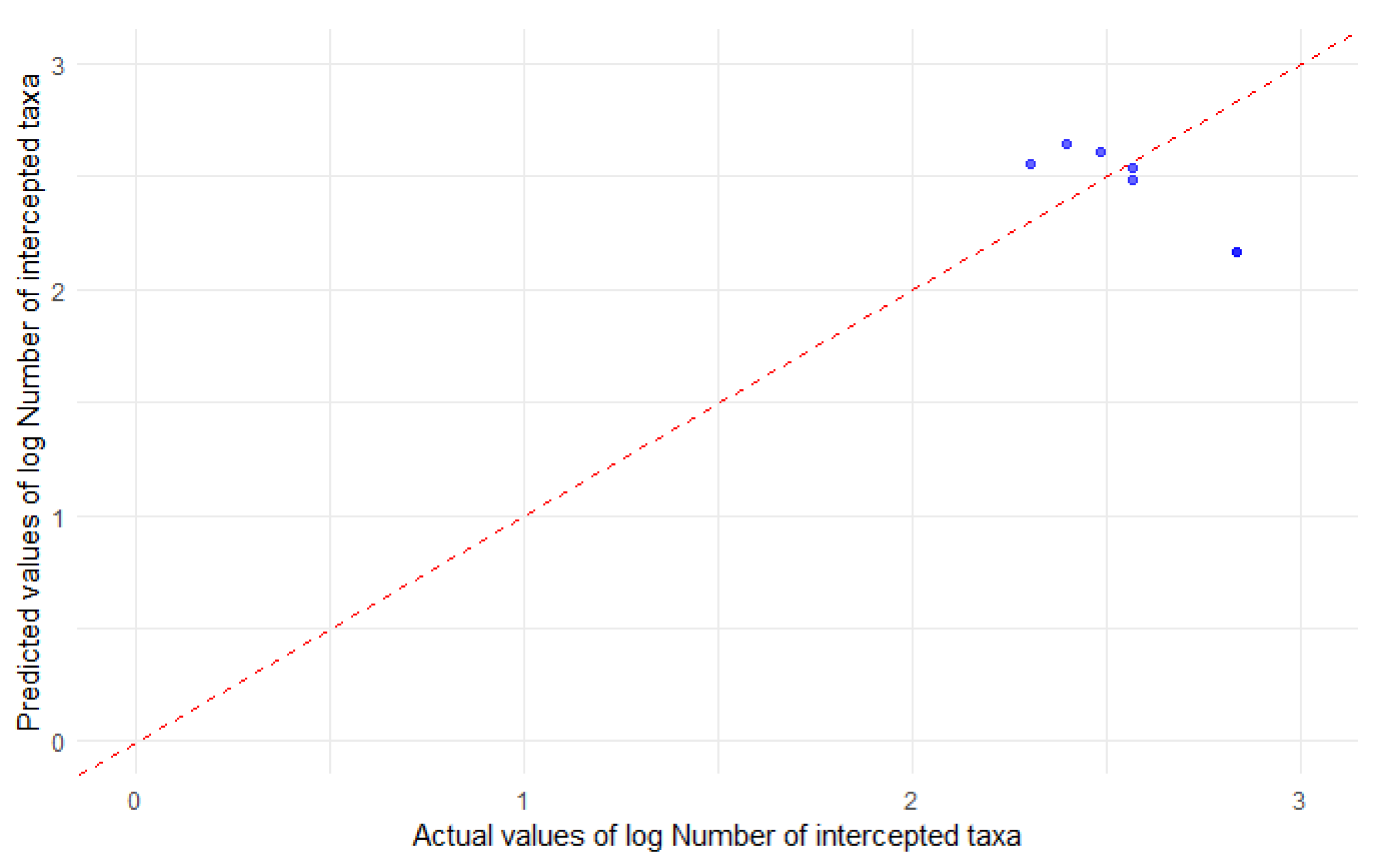
| Network | Diversity | ||||||
|---|---|---|---|---|---|---|---|
| Alatalo Interaction Evenness | Linkage Density | Interaction Strength Asymmetry | Nestedness | Inverse Simpson | Fisher’s Alpha | ||
| Number of interceptions | p < 0.05 | - | - | - | - | - | - |
| sign | - | - | - | - | - | - | |
| adjusted R2 | - | - | - | - | - | - | |
| Number of intercepted taxa | p < 0.05 | - | 0.036 | - | - | 0.011 | - |
| sign | - | ↑ | - | - | ↑ | - | |
| adjusted R2 | - | 0.106 | - | - | 0.166 | - | |
| Proportion of imports by road | p < 0.05 | 0.002 | 0.000 | 0.033 | 0.000 | 0.010 | - |
| sign | ↓ | ↑ | ↑ | ↓ | ↑ | - | |
| adjusted R2 | 0.255 | 0.487 | 0.110 | 0.321 | 0.170 | - | |
Disclaimer/Publisher’s Note: The statements, opinions and data contained in all publications are solely those of the individual author(s) and contributor(s) and not of MDPI and/or the editor(s). MDPI and/or the editor(s) disclaim responsibility for any injury to people or property resulting from any ideas, methods, instructions or products referred to in the content. |
© 2025 by the authors. Licensee MDPI, Basel, Switzerland. This article is an open access article distributed under the terms and conditions of the Creative Commons Attribution (CC BY) license (https://creativecommons.org/licenses/by/4.0/).
Share and Cite
Sing, K.-W.; Peden, R.; Hicks, D. Tracking Biosecurity Through the Diversity and Network Structure of International Trade. Diversity 2025, 17, 213. https://doi.org/10.3390/d17030213
Sing K-W, Peden R, Hicks D. Tracking Biosecurity Through the Diversity and Network Structure of International Trade. Diversity. 2025; 17(3):213. https://doi.org/10.3390/d17030213
Chicago/Turabian StyleSing, Kong-Wah, Rachel Peden, and Damien Hicks. 2025. "Tracking Biosecurity Through the Diversity and Network Structure of International Trade" Diversity 17, no. 3: 213. https://doi.org/10.3390/d17030213
APA StyleSing, K.-W., Peden, R., & Hicks, D. (2025). Tracking Biosecurity Through the Diversity and Network Structure of International Trade. Diversity, 17(3), 213. https://doi.org/10.3390/d17030213






